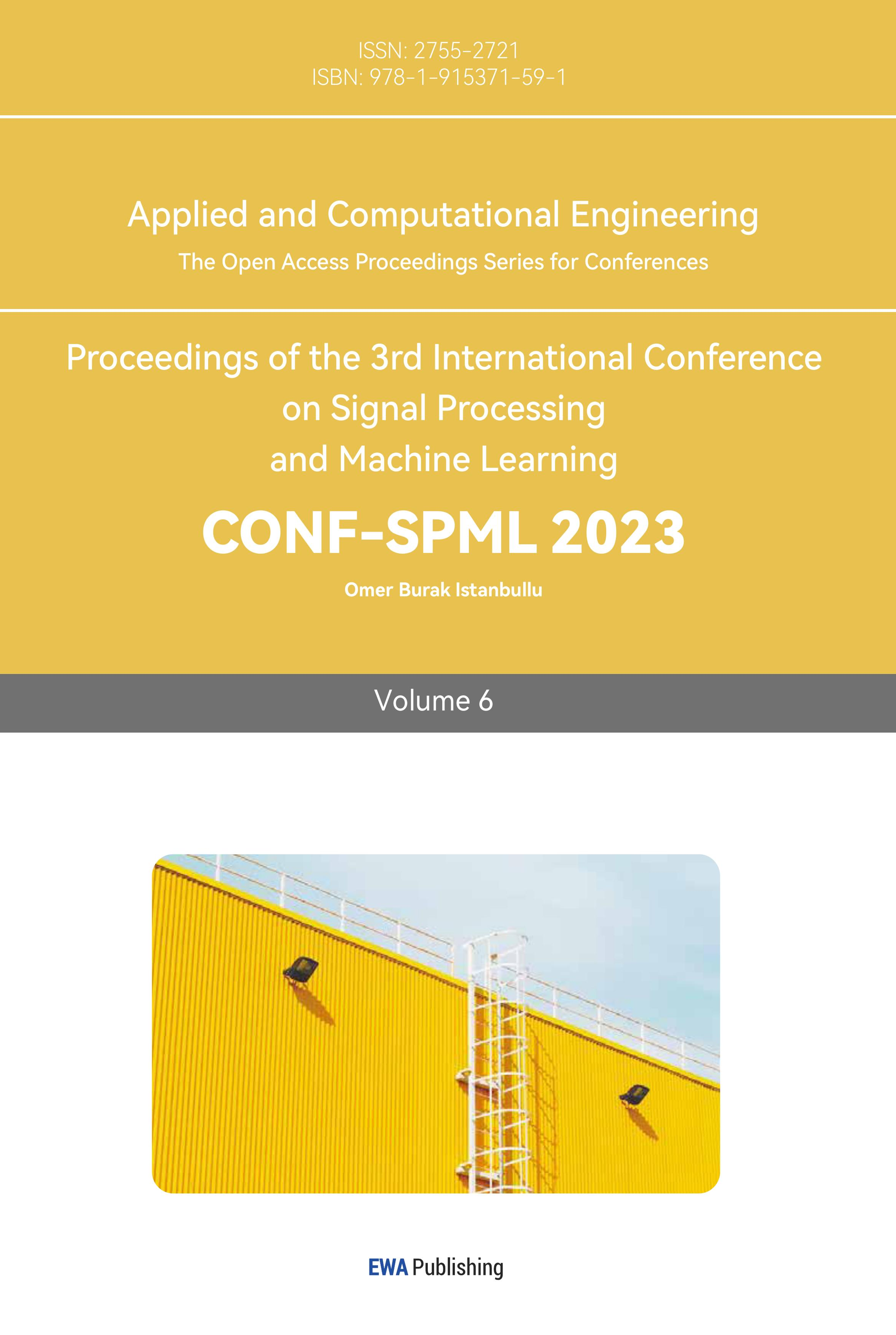References
[1]. Fayaz, L., Bisma, B., Nahida, N. Applied artificial intelligence: A bibliometric study of an International Journal. COLLNET Journal of Scientometrics and Information Management 15, 27-45 (2021). 10.1080/09737766.2021.1938742.
[2]. Jiang, J., Lv, Z. M., Lv, F. J., Fu, B. J., Liang, Z. R., Chu, Z. G. Clinical and Computed Tomography Characteristics of Solitary Pulmonary Nodules Caused by Fungi: A Comparative Study. Infection and drug resistance 15, 6019-6028 (2022). https://doi.org/10.2147/IDR.S382289.
[3]. Callister, M. E., Baldwin, D. R. How should pulmonary nodules be optimally investigated and managed?. Lung cancer (Amsterdam, Netherlands) 91, 48-55 (2016). https://doi.org/10.1016/j.lungcan.2015.10.018.
[4]. Sverzellati, N., Calabró, E., Randi, G., la Vecchia, C., Marchianò, A.V., Kuhnigk, J., Zompatori, M., Spagnolo, P., Pastorino, U. Sex differences in emphysema phenotype in smokers without airflow obstruction. European Respiratory Journal 33, 1320-1328 (2009).
[5]. American Society of Clinical Oncology (ASCO). Lung Cancer - Non-Small Cell: Statistics. Approved by the Cancer.Net Editorial Board (2022). https://www.oncotarget.com/.
[6]. McNulty, W., Baldwin, D. Management of pulmonary nodules. BJR open 1(1), 20180051 (2019). https://doi.org/10.1259/bjro.20180051.
[7]. Dilger, S. K., Uthoff, J., Judisch, A., Hammond, E., Mott, S. L., Smith, B. J., Newell, J. D., Jr, Hoffman, E. A., Sieren, J. C. Improved pulmonary nodule classification utilizing quantitative lung parenchyma features. Journal of medical imaging (Bellingham, Wash.) 2(4), 041004 (2015). https://doi.org/10.1117/1.JMI.2.4.041004.
[8]. Huang, Y., Liu, Z., He, L., Chen, X., Pan, D., Ma, Z., Liang, C., Tian, J., Liang, C. Radiomics Signature: A Potential Biomarker for the Prediction of Disease-Free Survival in Early-Stage (I or II) Non-Small Cell Lung Cancer. Radiology 281(3), 947–957 (2016). https://doi.org/10.1148/radiol.2016152234.
[9]. Hawkins, S.H., Wang, H., Liu, Y., Garcia, A.L., Stringfield, O., Krewer, H., Li, Q., Cherezov, D., Gatenby, R.A., Balagurunathan, Y., Goldgof, D., Schabath, M.B., Hall, L.O., Gillies, R.J. Predicting Malignant Nodules from Screening CT Scans. Journal of Thoracic Oncology 11, 2120-2128 (2016).
[10]. Robotic Oncology. History and the future of Robotic Surgery. https://www.roboticoncology.com/history-of-robotic-surgery/#:~:text=In%202000%2C%20the%20da%20Vinci%20Surgery%20System%20broke,all-encompassing%20system%20of%20surgical%20instruments%20and%20camera%2Fscopic%20utensils.
Cite this article
Zhou,Y. (2023). A study on the application and limitations of artificial intelligence in the treatment of lung cancer. Applied and Computational Engineering,6,638-642.
Data availability
The datasets used and/or analyzed during the current study will be available from the authors upon reasonable request.
Disclaimer/Publisher's Note
The statements, opinions and data contained in all publications are solely those of the individual author(s) and contributor(s) and not of EWA Publishing and/or the editor(s). EWA Publishing and/or the editor(s) disclaim responsibility for any injury to people or property resulting from any ideas, methods, instructions or products referred to in the content.
About volume
Volume title: Proceedings of the 3rd International Conference on Signal Processing and Machine Learning
© 2024 by the author(s). Licensee EWA Publishing, Oxford, UK. This article is an open access article distributed under the terms and
conditions of the Creative Commons Attribution (CC BY) license. Authors who
publish this series agree to the following terms:
1. Authors retain copyright and grant the series right of first publication with the work simultaneously licensed under a Creative Commons
Attribution License that allows others to share the work with an acknowledgment of the work's authorship and initial publication in this
series.
2. Authors are able to enter into separate, additional contractual arrangements for the non-exclusive distribution of the series's published
version of the work (e.g., post it to an institutional repository or publish it in a book), with an acknowledgment of its initial
publication in this series.
3. Authors are permitted and encouraged to post their work online (e.g., in institutional repositories or on their website) prior to and
during the submission process, as it can lead to productive exchanges, as well as earlier and greater citation of published work (See
Open access policy for details).
References
[1]. Fayaz, L., Bisma, B., Nahida, N. Applied artificial intelligence: A bibliometric study of an International Journal. COLLNET Journal of Scientometrics and Information Management 15, 27-45 (2021). 10.1080/09737766.2021.1938742.
[2]. Jiang, J., Lv, Z. M., Lv, F. J., Fu, B. J., Liang, Z. R., Chu, Z. G. Clinical and Computed Tomography Characteristics of Solitary Pulmonary Nodules Caused by Fungi: A Comparative Study. Infection and drug resistance 15, 6019-6028 (2022). https://doi.org/10.2147/IDR.S382289.
[3]. Callister, M. E., Baldwin, D. R. How should pulmonary nodules be optimally investigated and managed?. Lung cancer (Amsterdam, Netherlands) 91, 48-55 (2016). https://doi.org/10.1016/j.lungcan.2015.10.018.
[4]. Sverzellati, N., Calabró, E., Randi, G., la Vecchia, C., Marchianò, A.V., Kuhnigk, J., Zompatori, M., Spagnolo, P., Pastorino, U. Sex differences in emphysema phenotype in smokers without airflow obstruction. European Respiratory Journal 33, 1320-1328 (2009).
[5]. American Society of Clinical Oncology (ASCO). Lung Cancer - Non-Small Cell: Statistics. Approved by the Cancer.Net Editorial Board (2022). https://www.oncotarget.com/.
[6]. McNulty, W., Baldwin, D. Management of pulmonary nodules. BJR open 1(1), 20180051 (2019). https://doi.org/10.1259/bjro.20180051.
[7]. Dilger, S. K., Uthoff, J., Judisch, A., Hammond, E., Mott, S. L., Smith, B. J., Newell, J. D., Jr, Hoffman, E. A., Sieren, J. C. Improved pulmonary nodule classification utilizing quantitative lung parenchyma features. Journal of medical imaging (Bellingham, Wash.) 2(4), 041004 (2015). https://doi.org/10.1117/1.JMI.2.4.041004.
[8]. Huang, Y., Liu, Z., He, L., Chen, X., Pan, D., Ma, Z., Liang, C., Tian, J., Liang, C. Radiomics Signature: A Potential Biomarker for the Prediction of Disease-Free Survival in Early-Stage (I or II) Non-Small Cell Lung Cancer. Radiology 281(3), 947–957 (2016). https://doi.org/10.1148/radiol.2016152234.
[9]. Hawkins, S.H., Wang, H., Liu, Y., Garcia, A.L., Stringfield, O., Krewer, H., Li, Q., Cherezov, D., Gatenby, R.A., Balagurunathan, Y., Goldgof, D., Schabath, M.B., Hall, L.O., Gillies, R.J. Predicting Malignant Nodules from Screening CT Scans. Journal of Thoracic Oncology 11, 2120-2128 (2016).
[10]. Robotic Oncology. History and the future of Robotic Surgery. https://www.roboticoncology.com/history-of-robotic-surgery/#:~:text=In%202000%2C%20the%20da%20Vinci%20Surgery%20System%20broke,all-encompassing%20system%20of%20surgical%20instruments%20and%20camera%2Fscopic%20utensils.









